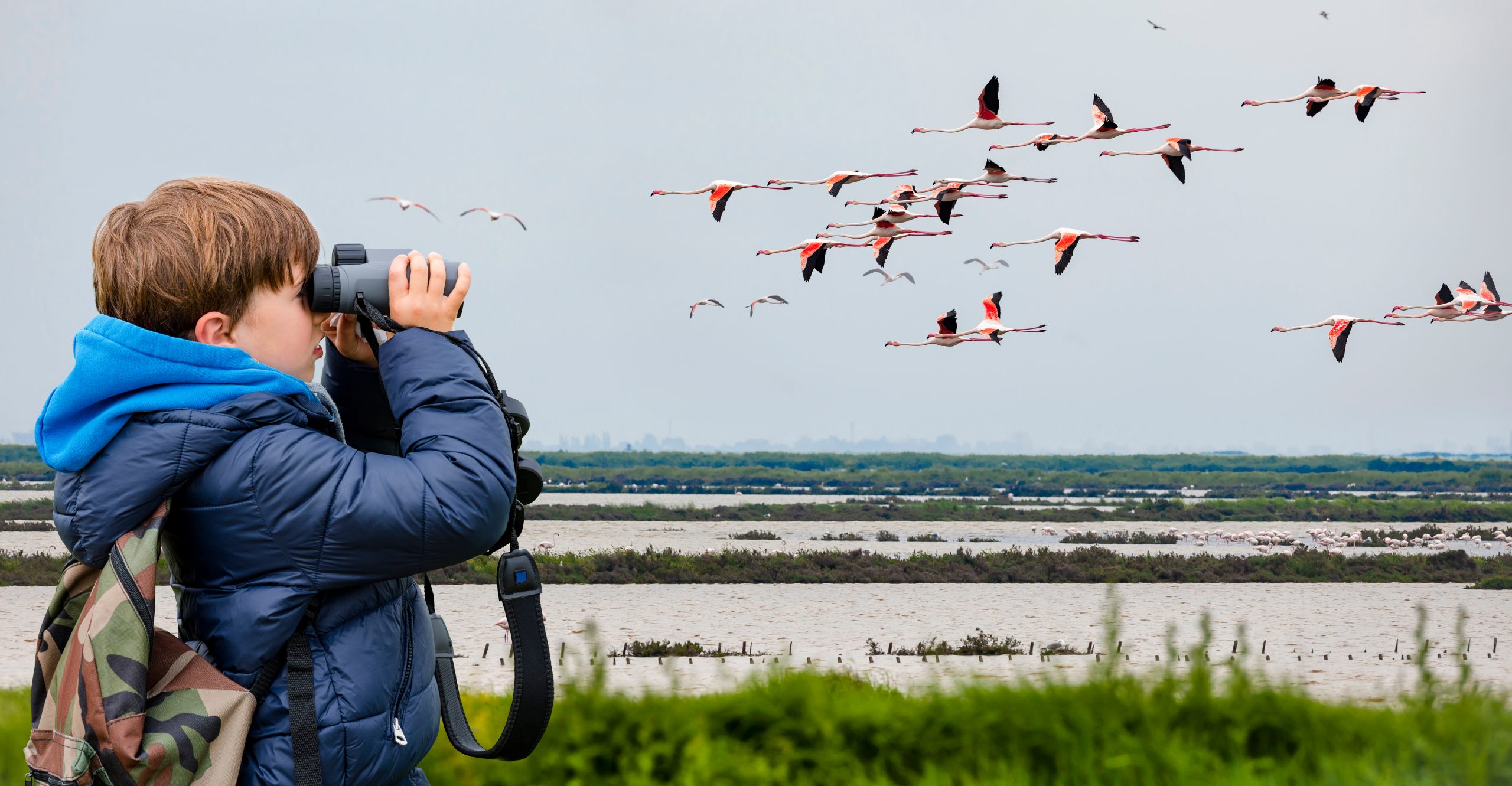A few weeks ago, my family and I spent an afternoon at the lake. It was a hot day, and the fresh water was the perfect refuge from the sunbeams beating down on us. At one point, I took out a small kayak by myself. As I rowed across the lake’s glassy surface, I caught sight of something gliding through the sky. I rowed faster and drew closer to the shore, only to see an osprey soaring above me.
Two massive wings propelled the bird across the sky. I watched as it swooped down and caught a fish in its claws, then carried it across the lake to a nest perched high in an evergreen. I stared at the nest for a few minutes, watching the mother osprey feed its young. It was one of those awesome, once-in-a-lifetime moments, and helped me realize just how exciting bird-watching can be.
Bird-watching is a great hobby for kids and adults of all ages. It’s calming, helps kids deepen their connection to the great outdoors, and benefits overall mental wellbeing. While you can bird-watch with your naked eye, like I did, your viewing experience can be enhanced tenfold with a single pair of binoculars. But why should you and your family use bird-watching binoculars, and what’s the best pair on the market?
Let’s make like a falcon and dive right into Troomi’s guide to bird-watching binoculars.
Why Should My Family Use Bird-watching Binoculars?
Binoculars are the single most important piece of equipment for aspiring bird-watchers. While you can watch larger birds—like ospreys—with your naked eye, you’ll likely miss out on the intimate moments unless you have a pair of binoculars. They help birders see the details—a necessary part of determining what species they’re looking at. With a good pair of binoculars, you’ll never wonder at the difference between an unladen African swallow and their European counterpart again.
Some birders may try to sell you on using other optical enhancers for your bird-watching. While spotting scopes and highly magnified camera lenses will certainly help you get those sweet views of our avian friends, they aren’t as advantageous as a good ol’ fashioned pair of binoculars. This is because binoculars act as a natural enhancement for your two-eyed vision, giving you a wider field of view and allowing you to see in three dimensions.
Binoculars are also much more convenient than other forms of magnification, because they’re lightweight and easy to carry. Spotting scopes require tripods and cameras necessitate a big bag full of different lenses, while binoculars are a one-and-done piece of equipment. Simply strap them around your neck and you’re ready to go!
What Makes a Good Pair of Binoculars?
Now that I’ve sold you on using binoculars over other forms of magnification, let’s talk a little bit more about what makes a good pair of binoculars. According to the National Audubon Society, there are three things to consider when purchasing a new pair of binoculars:
- Image quality. How does the magnified image look? Are the birds you’re watching in-focus and appropriately colored?
- Overall feel. How do the binoculars feel in your hands and on your eyes? Are they balanced and easy to focus?
- Eye comfort. Binoculars are notorious for being hard on the eyes. A good pair of binoculars gives your eyes some relief and doesn’t necessitate any strain.
What Size of Binoculars Is Best?
There are as many different sizes of binoculars as there are birds in the sky, so which one is best for bird-watching?
The general consensus is that 8×42 is the best size of binoculars for beginning birders. This indicates that the magnification power is 8x, while the front lens (or objective lens) is 42 millimeters in diameter. A good pair of 8×42 binoculars allows you to zoom in close enough to see small details, while maintaining a good amount of light.
Of course, the best size of binoculars depends on what type of birds you and your family are trying to watch! If you and the kiddos are excited about watching small birds from far away, binoculars with higher magnification may be a good idea. Just be aware that the more powerful the magnification, the more small movements and vibrations will mess with your viewing experience.
The same can be said for the appropriate lens diameter size. A larger objective lens diameter will brighten up your image and be a bit easier on the eyes. As you increase the diameter size, however, the overall size and weight of your binoculars increases accordingly. Remember that you and your kids are responsible for carrying and holding the binoculars throughout your entire birding journey. A few ounces can make a big difference when you’re stuck carrying binoculars for miles.
What Are the Best Bird-watching Binoculars for Beginners?
Eric Lind of Audobon says that “the best binoculars are the ones that you fall in love with and the ones that keep you excited about birding. To find that pair, do your homework, evaluate the options, try before you buy, and get the best pair your budget allows.”
With that in mind, here are some of the best budget binoculars for beginning birders, according to Audubon.
- Nikon Prostaff 3S 8×42. Listed at $130, these binoculars are lightweight and portable—perfect for kids to carry on long birding journeys. They’re also waterproof and come with a limited lifetime warranty, so you don’t have to stress as much when your kids have them in hand.
- Bushnell Prime 8×42. These binoculars are celebrated for their brilliant color rendition and top-of-the-line optics. They’re $140 and are totally waterproof and fogproof.
- Celestron Nature DX 8×42. From a purely aesthetic standpoint, these binoculars are my favorite on the list. Rolling in at $150, they’re a fresh forest green and, according to Audubon, “their bright, sharp images impressed.”
- Athlon Neos 8×42. If your teens have larger hands, these may be the binoculars for them. They’re also on the cheaper side, coming in at a solid $110.
- Tasco Essentials 8×42. Looking to birdwatch on a budget? These are the binoculars for you. They’re a solid $50, and at half the weight of the rest of the binoculars on this list, they may be the best option for younger kids wanting to explore the wonderful world of birding.
Bird-watching Gets Your Family Outside
As summer fades into fall and the kids spend all day at school, it’s more important than ever to make time for the outdoors. Bird-watching is a great way to spend some quality time with nature and make some fun family memories in the process. With these bird-watching binocular tips, your next birding adventure is sure to be a memorable one!
And be sure to bring your kiddo’s Troomi phone along for the ride! The top-of-the-line camera makes it easy to preserve outdoor memories—and take photos of those rare birds.


